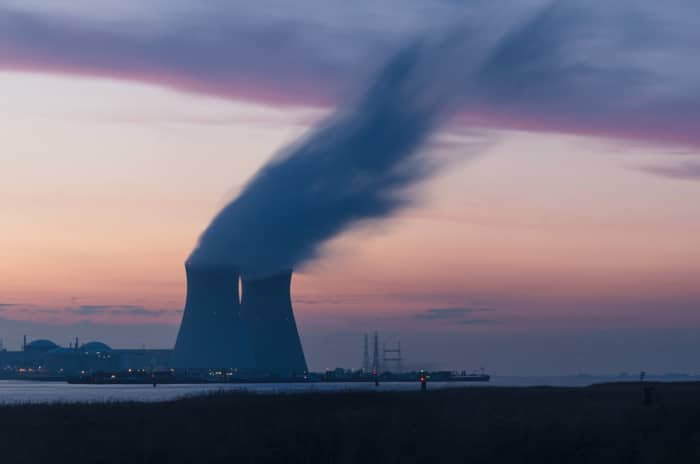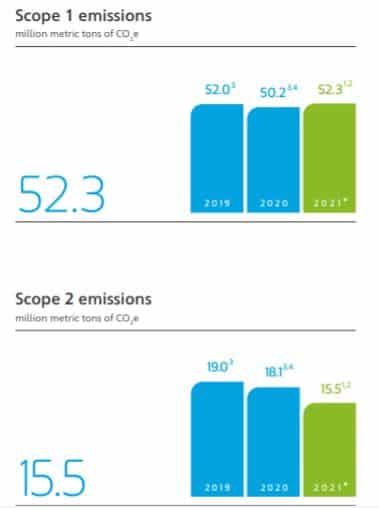Saudi Aramco published its first sustainability report that outlines ways how it can reduce its emissions, including 16 million carbon offsets.
The world’s biggest oil company detailed its plan and strategies on how to abate its carbon emissions in its first-ever sustainability report.
The report also reveals the company’s interim climate targets to achieve by 2035. And a big part of that goal is to use 16 million carbon credit offsets or metric tons of CO2e each year.
Before releasing the report, the oil firm announced its ambition to reach net zero Scope 1 and 2 emissions by 2050.
At a glance, here are Aramco’s primary climate goals:
- Produce 11 million mt/year of blue ammonia by 2030
- Reduce more than 50 million mt of CO2 equivalent annually by 2035
- Reach net zero Scope 1 and Scope 2 emissions from its assets by 2050
Aramco’s Upstream Carbon Intensity (Scope 1 and 2 Emissions)
Saudi Arabia, the biggest oil exporter, made a pledge to have net zero emissions by 2060, 10 years later than Aramco’s goal.
Aramco is now rapidly reducing its GHG emissions. At the same time, ramping up its most sustainable capacity for crude oil (from 12 million b/d now to 13 million b/d by 2027).
The firm’s chairman Yasir al-Rumayyan stated in the report:
“Reducing emissions from energy production and use, while at the same time satisfying the world’s growing energy requirements, is the biggest dual challenge facing our industry.”
Saudi officials believe that demand for the country’s crude will remain strong. That’s because the country enjoys low cost and low carbon production.
- Aramco aims to reduce its net Scope 1 and Scope 2 emissions by 52 million mtCO2e annually by 2035.
Right now, here’s the oil major’s Scope 1 and 2 GHG emissions.
To cut down these upstream emissions, Aramco is making use of the Circular Carbon Economy framework. It focuses on reducing, reusing, recycling, and removing GHG emissions. Under this model, the firm aims to achieve emissions reduction by 2035 with these interim targets:
- Renewables investment: 14 million Mt of CO2e reduction/year
- Carbon Capture, Utilization, and Storage (CCUS) investment: 11 million Mt of CO2e reduction/year
- Energy efficiency improvements: 11 million Mt of CO2e reduction/year
- Methane and flaring reduction — 1 million Mt of CO2e reduction/year
- Carbon credit offsets — 16 million Mt of CO2e mitigation/year
The company also plans to further reduce its upstream carbon intensity despite being the lowest in the industry.
It seeks to cut it by 15%, from 10.2kg CO2 equivalent per barrel of oil equivalent (boe) to 8.7kg of CO2e/boe by 2035.
When it comes to Scope 3 emissions (supply chain and customers’ use of products), Aramco has not reported it yet. But the firm is investing in hydrogen and renewable energy sources that support customers to access lower carbon products.
The report also outlines the oil giant’s focus on developing its blue ammonia and hydrogen business. In particular, it seeks to produce up to 11 million metric tons of blue ammonia per year by 2030.
The goal is to support emissions reductions in hard-to-abate sectors like heavy-duty transport, heating, and industrial applications.
Aramco’s Carbon Credits and Offsets
- Aramco will further cut its emissions by 14% in 2035 by investing in projects that produce up to 16 million carbon offsets annually.
Carbon offsets refer to the units of carbon credits that Aramco plans to earn through emission reduction projects. One carbon credit equals one metric ton of GHG emission removed or avoided.
The use of offsets is an important part of Aramco’s net zero goal as they enable the mitigation of hard-to-abate emissions.
By buying carbon credits in the carbon market, the firm can offset its emissions in reduction elsewhere. In effect, the carbon credit offsets allow Aramco to speed up its reduction efforts.
In 2021, Aramco’s Scope 1 emissions jump by 4% after the start-up of its Fadhili Gas plant. Meanwhile, the company saw a 14% drop in Scope 2 emissions due to a shift in consumption of electricity from third-party to company-owned power generation.
Aramco is now exploring the use of natural climate solutions to generate carbon credits. In fact, it partners with Public Investment Fund (Saudi Arabia’s wealth fund) to be the first member of the Riyadh Voluntary Exchange Platform.
The platform is where trading of carbon credits and offsets will happen in the Middle East and North Africa. This MENA voluntary carbon market (VCM) which Aramco is part will take off next year.
The initiative is timely as it can tap the growing demand for carbon credits (offsets) in the VCM.
Aramco said in its report that carbon credits are vital in their journey to reach net zero emissions by 2050. Their use will help the company reduce emissions and be more sustainable.



